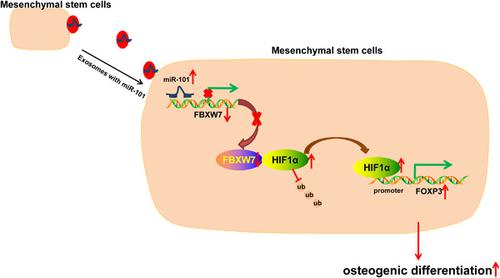当前位置:
X-MOL 学术
›
J. Cell. Physiol.
›
论文详情
Our official English website, www.x-mol.net, welcomes your
feedback! (Note: you will need to create a separate account there.)
miR‐101‐loaded exosomes secreted by bone marrow mesenchymal stem cells requires the FBXW7/HIF1α/FOXP3 axis, facilitating osteogenic differentiation
Journal of Cellular Physiology ( IF 4.5 ) Pub Date : 2021-01-12 , DOI: 10.1002/jcp.30027 Yanhong Li 1 , Jing Wang 1 , Yanchao Ma 1 , Wenjia Du 1 , Kai Feng 1 , Shuanke Wang 1
Journal of Cellular Physiology ( IF 4.5 ) Pub Date : 2021-01-12 , DOI: 10.1002/jcp.30027 Yanhong Li 1 , Jing Wang 1 , Yanchao Ma 1 , Wenjia Du 1 , Kai Feng 1 , Shuanke Wang 1
Affiliation

|
Exosomes derived from mesenchymal stem cells (MSCs) have emerged as significant mediators of intercellular communication, with studies highlighting their role in the transmission of biological signals between cells. Dominant microRNA (miRNA)‐mediated translational repression of messenger RNAs has been extensively investigated in regard to its influence in orchestrating osteogenic differentiation. In the current study, we sought to ascertain the contributory role of miRNA‐101 (miR‐101) encapsulated in the process of bone marrow mesenchymal stem cell (BMSC)‐derived exosomes in osteogenic differentiation. Exosomes were initially extracted from BMSCs at Days 0, 3, 12, and 21 of osteogenic differentiation by ultracentrifugation. Artificial modulation of miR‐101 and FBXW7 (silencing and overexpression) were performed in the BMSCs to identify its effects on osteogenic factors, alkaline phosphatase activity, and osteogenic differentiation. Mechanistic exploration was performed to evaluate the binding affinity between miR‐101 and FBXW7, the FBXW7‐mediated HIF1α ubiquitination, and the HIF1α enrichment in the FOXP3 promoter region. Exosomes from MSCs in the late stage of osteogenic differentiation exhibited enhanced osteogenic differentiation. Upregulated miR‐101 in MSC‐derived exosomes was detected during osteogenic differentiation, while diminished levels of FBXW7 expression was noted. Importantly, miR‐101 was found to specifically bind to the 3′‐untranslated region of FBXW7. Meanwhile, data was obtained indicating that FBXW7 could ubiquitinate and degrade HIF1α to repress its upregulation during osteogenic differentiation. HIF1α bound to the promoter region of FOXP3 to facilitate osteogenic differentiation. Ultimately, the findings of the current study demonstrate that BMSC‐derived exosomal miR‐101 augments osteogenic differentiation in MSCs by inhibiting FBXW7 to regulate the HIF1α/FOXP3 axis.
中文翻译:

骨髓间充质干细胞分泌的 miR-101 外泌体需要 FBXW7/HIF1α/FOXP3 轴,促进成骨分化
源自间充质干细胞 (MSC) 的外泌体已成为细胞间通讯的重要介质,研究强调了它们在细胞间生物信号传输中的作用。显性 microRNA (miRNA) 介导的信使 RNA 的翻译抑制已就其在协调成骨分化中的影响进行了广泛研究。在目前的研究中,我们试图确定包裹在骨髓间充质干细胞 (BMSC) 衍生外泌体过程中的 miRNA-101 (miR-101) 在成骨分化过程中的作用。外泌体最初是在成骨分化的第 0、3、12 和 21 天通过超速离心从 BMSC 中提取的。在 BMSC 中进行 miR-101 和 FBXW7 的人工调节(沉默和过表达),以确定其对成骨因子、碱性磷酸酶活性和成骨分化的影响。进行机制探索以评估 miR-101 和 FBXW7 之间的结合亲和力、FBXW7 介导的 HIF1α 泛素化以及 FOXP3 启动子区域中的 HIF1α 富集。在成骨分化后期,来自 MSCs 的外泌体表现出增强的成骨分化。在成骨分化过程中检测到 MSC 衍生的外泌体中的 miR-101 上调,同时注意到 FBXW7 表达水平降低。重要的是,发现 miR-101 与 FBXW7 的 3' 非翻译区特异性结合。同时,获得的数据表明 FBXW7 可以泛素化和降解 HIF1α 以抑制其在成骨分化过程中的上调。HIF1α 与 FOXP3 的启动子区域结合以促进成骨分化。最终,目前的研究结果表明,BMSC 衍生的外泌体 miR-101 通过抑制 FBXW7 调节 HIF1α/FOXP3 轴来增强 MSC 中的成骨分化。
更新日期:2021-03-23
中文翻译:

骨髓间充质干细胞分泌的 miR-101 外泌体需要 FBXW7/HIF1α/FOXP3 轴,促进成骨分化
源自间充质干细胞 (MSC) 的外泌体已成为细胞间通讯的重要介质,研究强调了它们在细胞间生物信号传输中的作用。显性 microRNA (miRNA) 介导的信使 RNA 的翻译抑制已就其在协调成骨分化中的影响进行了广泛研究。在目前的研究中,我们试图确定包裹在骨髓间充质干细胞 (BMSC) 衍生外泌体过程中的 miRNA-101 (miR-101) 在成骨分化过程中的作用。外泌体最初是在成骨分化的第 0、3、12 和 21 天通过超速离心从 BMSC 中提取的。在 BMSC 中进行 miR-101 和 FBXW7 的人工调节(沉默和过表达),以确定其对成骨因子、碱性磷酸酶活性和成骨分化的影响。进行机制探索以评估 miR-101 和 FBXW7 之间的结合亲和力、FBXW7 介导的 HIF1α 泛素化以及 FOXP3 启动子区域中的 HIF1α 富集。在成骨分化后期,来自 MSCs 的外泌体表现出增强的成骨分化。在成骨分化过程中检测到 MSC 衍生的外泌体中的 miR-101 上调,同时注意到 FBXW7 表达水平降低。重要的是,发现 miR-101 与 FBXW7 的 3' 非翻译区特异性结合。同时,获得的数据表明 FBXW7 可以泛素化和降解 HIF1α 以抑制其在成骨分化过程中的上调。HIF1α 与 FOXP3 的启动子区域结合以促进成骨分化。最终,目前的研究结果表明,BMSC 衍生的外泌体 miR-101 通过抑制 FBXW7 调节 HIF1α/FOXP3 轴来增强 MSC 中的成骨分化。











































 京公网安备 11010802027423号
京公网安备 11010802027423号